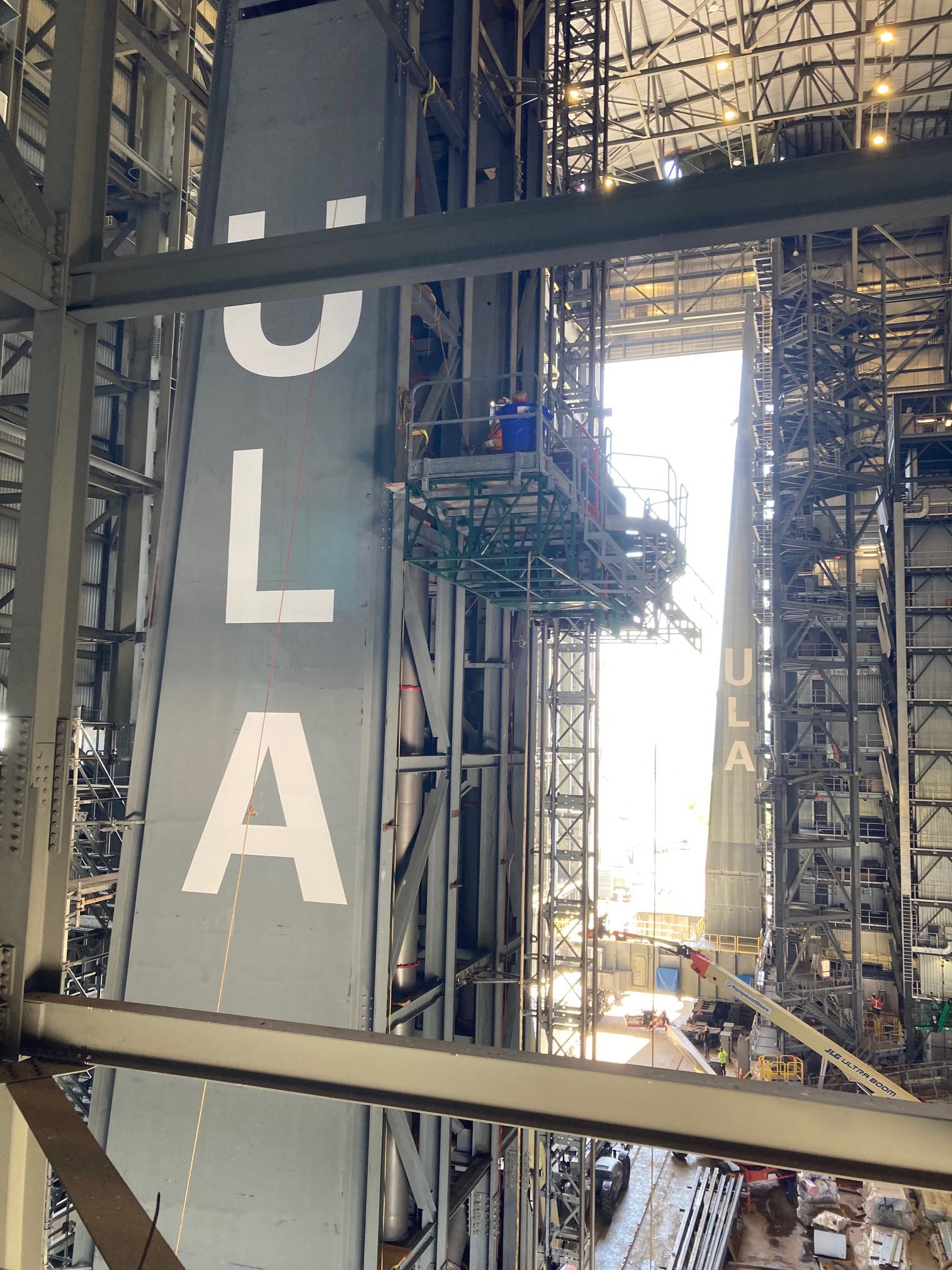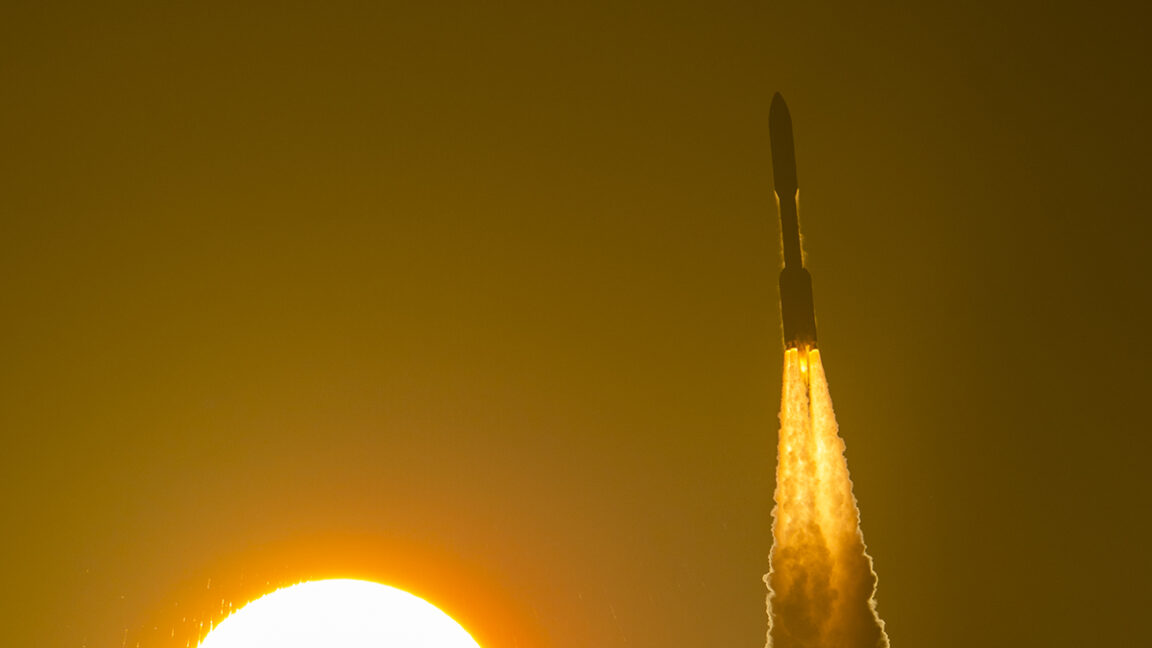Crunch time—we’ll soon find out if Amazon’s launch providers are up to the job
June 23, 2025
For the second time in two months, United Launch Alliance sent a batch of 27 broadband Internet satellites into orbit for Amazon on Monday morning.
Just like the last flight on April 28, an Atlas V rocket lifted off from Cape Canaveral, Florida, and delivered Amazon’s satellites into an on-target orbit roughly 280 miles (450 kilometers) above Earth. This was the second launch of a full load of operational satellites for Amazon’s Project Kuiper, a network envisioned to become a competitor to SpaceX’s Starlink.
The Atlas V launched at 6:54 am EDT (10:54 UTC) on Monday, a week after ULA scrubbed the mission’s first countdown to address a problem with the rocket’s Russian-made RD-180 main engine. With that issue resolved, ULA’s launch team gave a “go” for Monday morning’s sunrise liftoff.
The rocket climbed away from its launch pad at Cape Canaveral, assisted by five strap-on solid-fueled boosters. Heading northeast over the Atlantic Ocean, the rocket jettisoned its five spent booster casings, payload fairing, and first stage in the first five minutes of the flight. The rocket’s Centaur upper stage ignited to finish the job of placing Amazon’s next 27 satellites into orbit.
Amazon and ULA confirmed the successful conclusion of the launch, bringing the total number of operational Kuiper satellites deployed in orbit to 54.
A long way to go
Project Kuiper has now completed three launches, including a test launch in 2023 with a pair of Kuiper prototypes. When complete, the network’s architecture will consist of 3,232 satellites in low-Earth orbit, enabling coverage of most of the populated world.
Amazon has procured more than 80 launches with four companies to put all of these satellites into orbit. ULA won the lion’s share of the launch contracts to deploy more than half of the Kuiper constellation. Amazon purchased the last nine Atlas V rockets before ULA retires the vehicle in favor of the newer Vulcan rocket. Shortly thereafter, Amazon signed a contract for 38 Vulcan flights, each of which ULA says will deliver 45 Kuiper satellites into orbit.
Europe’s Ariane 6 rocket is under contract for 18 missions with Kuiper satellites. The New Glenn from Blue Origin, owned by Amazon founder Jeff Bezos, will launch at least 12 times to add satellites to the Kuiper network. Amazon has a contract option with Blue Origin for up to 15 additional New Glenn launches.
These newer rockets don’t have much of a track record. ULA and Arianespace have each flown their Vulcan and Ariane 6 rockets twice, and Blue Origin’s New Glenn has completed just one launch. The Atlas V rocket is nearing retirement, and ULA has no more Atlas Vs available for purchase.
SpaceX’s Falcon 9 is the only rocket among Amazon’s launch providers that has actually flown at the kind of cadence envisioned for the Kuiper network. The Falcon 9 currently flies at an average rate of once every two days, primarily on missions with SpaceX’s own Starlink broadband satellites.
So Amazon went to SpaceX in 2023 and booked three initial rides on the Falcon 9. SpaceX’s Starlink network dominates the satellite broadband market, with more than 5 million subscribers connecting to approximately 7,000 satellites currently active in the constellation.
Amazon’s competitor will launch the next batch of Kuiper satellites on a Falcon 9 as soon as next month. Those satellites are already at Cape Canaveral for final launch preparations, suggesting that Amazon is finally overcoming difficulties in activating its spacecraft factory in Kirkland, Washington. A source recently told Ars that satellites for the fourth Kuiper launch are undergoing final testing in Kirkland. For the first time, Amazon will soon be in a position of waiting on rockets before launching them.
Flipping the script
This wasn’t always the case. While the newer Vulcan, New Glenn, and Ariane 6 rockets have faced delays, ULA has multiple Atlas V rockets complete and ready to move to the launch pad. ULA is ending the production of Atlas Vs and turning attention to manufacturing Vulcan launch vehicles at the company’s rocket factory in Decatur, Alabama. As those Atlas Vs came off the assembly line, ULA put them into storage to wait for Amazon to catch up on satellite production.
ULA aims to double its launch capacity at Cape Canaveral to meet Amazon’s demands. And Amazon is investing heavily to make it happen, committing $2 billion to pay for the expansion of ULA’s manufacturing and launch capacity, with around $500 million going toward upgrades at the Florida launch base.
Sources tell Ars that Blue Origin, which supplies BE-4 main engines for the Vulcan rocket, is performing well on engine deliveries to ULA’s rocket factory in Alabama. But bringing new infrastructure online at the Cape Canaveral spaceport is just as important as expanding ULA’s factory throughput.
Crews at Cape Canaveral are readying a second hangar, or Vertical Integration Facility, for assembling ULA’s rockets. Signifying its importance for Kuiper missions, ULA has named the new hangar VIF-A, with the “A” standing for “Amazon.” ULA has also built a second mobile launch platform for Vulcan missions. A third launch platform is strictly used for Atlas V rockets.
The idea is to enable ULA to run simultaneous launch campaigns while flying from a single launch pad. All of these changes are intended to help ULA ramp up its Florida launch cadence to two flights per month, or about 25 per year. Before now, Atlas V launches from Cape Canaveral have been limited to one mission per month at best.

Two mobile launch platforms for ULA’s Vulcan rocket are pictured inside the company’s second integration hangar soon to come online at Cape Canaveral, Florida.
Credit:
United Launch Alliance
Once the second VIF is ready in Florida, ULA plans to kick off the launch campaign for the first flight of Kuiper satellites on a Vulcan rocket. Meanwhile, after Monday’s Atlas V launch, the company will turn its immediate attention to its next mission—the first Vulcan launch for the US Space Force—scheduled to lift off in late July.
The schedule for launching Kuiper satellites on the Ariane 6 and New Glenn rockets is murkier. Arianespace could be in a position to launch a cluster of Kuiper satellites on an Ariane 6 rocket later this year, following the next Ariane 6 flight in August with a European weather satellite. The story for Blue Origin is not as optimistic.
The next New Glenn launch is scheduled no earlier than August, likely on a multi-payload rideshare mission. Ars has previously reported that this may well be the only New Glenn flight before the end of this year, punting the start of Blue Origin’s service for Kuiper until 2026.
Strictly speaking, there’s a deadline for Kuiper and its launch providers to get moving. The Federal Communications Commission stipulates that Amazon must deploy at least 1,616 satellites, half of the overall Kuiper constellation, by July 2026. Kuiper’s previous delays have already eliminated any chance of Amazon meeting the FCC’s deadline, but the time limit is movable, and the FCC has extended network authorization deadlines before.
“Precedent suggests Kuiper’s delays are normal and should resolve themselves as momentum builds,” Caleb Henry, director of research at the industry analytics firm Quilty Space, wrote in April. “Plus, given the magnitude of Kuiper’s investment, estimated at $16.5–20 billion by Quilty Space, the FCC is fully expected to grant an extension on the company’s spectrum license. All Amazon needs to do now is execute.”
The same can be said for the companies Amazon has chosen to put its satellites into space.
Search
RECENT PRESS RELEASES
Related Post






